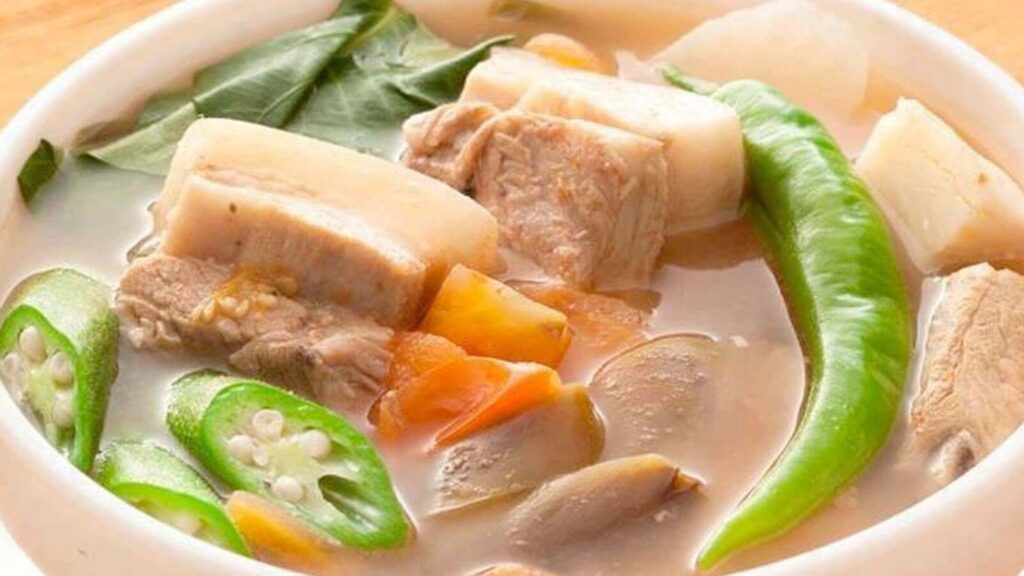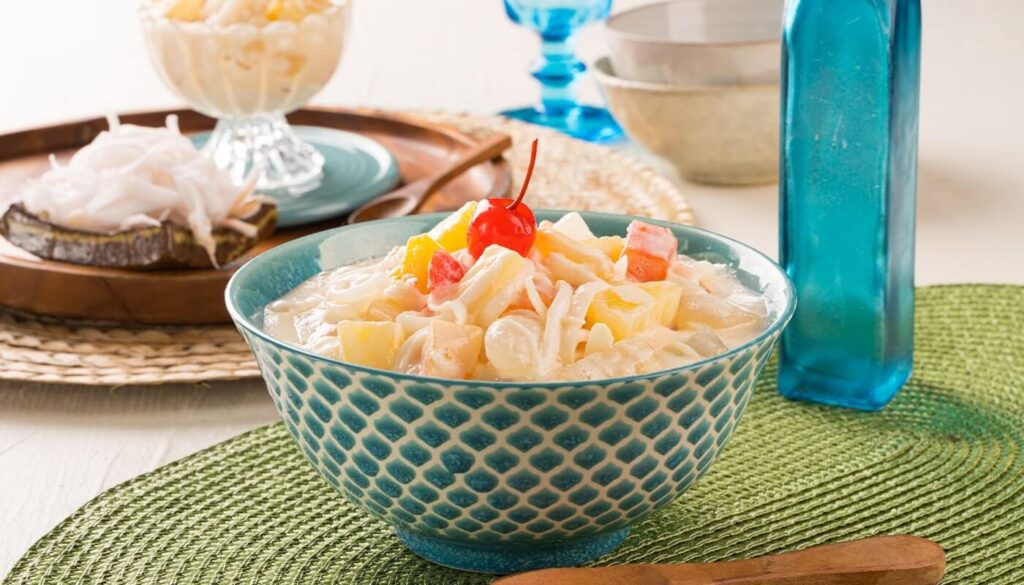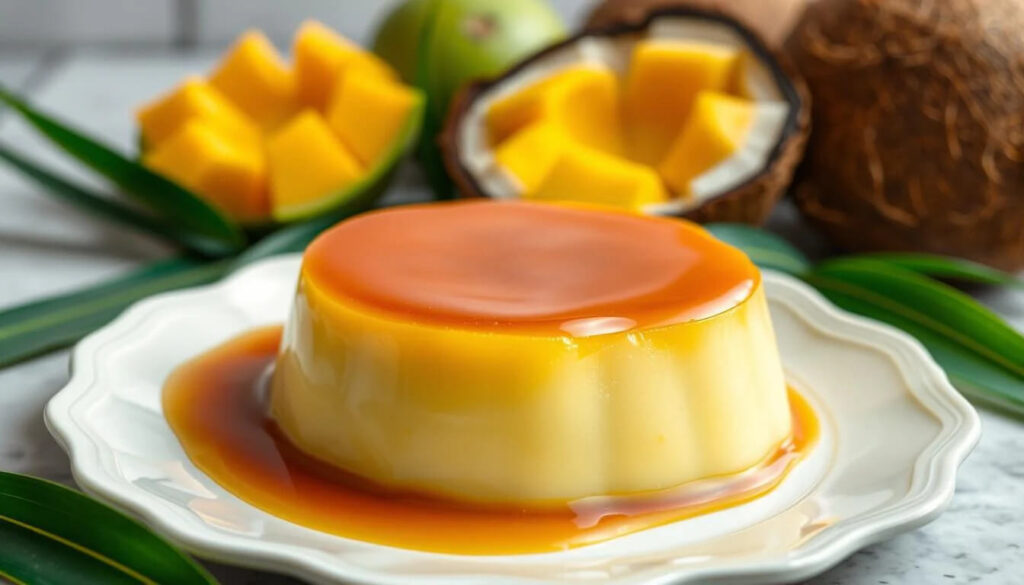Filipino celebration cuisine isn’t just food—it’s storytelling that connects generations. These Filipino dishes carry cultural significance, family traditions, and memories that span across time and geography.
Whether it’s a birthday, wedding, Christmas, or any special gathering, certain dishes are essential to Filipino celebrations. Each one tells a story of heritage, family bonds, and the Filipino spirit of bringing people together through food.
Let’s explore the dishes that define Filipino celebrations and discover what makes each one special.
Top 10 Filipino Dishes for Celebrations
- Lechon (Roast Pig)
- Lumpiang Shanghai (Filipino Spring Rolls)
- Pancit (Long-Life Noodles)
- Adobo (National Dish)
- Sinigang (Sour Soup)
- Inihaw (Filipino BBQ)
- Buko Salad (Coconut Fruit Salad)
- Leche Flan (Caramel Custard)
- Dinuguan with Puto (Blood Stew with Rice Cakes)
- Kare-Kare (Oxtail Peanut Stew)
Lechon

When a Filipino celebration has lechon, you know it’s a truly special occasion. This whole roasted pig with golden, crackling skin represents the centerpiece of major Filipino festivities. The preparation is an art form—slowly roasted over charcoal for hours until the skin achieves that perfect crispy texture while the meat remains tender and flavorful.
The presence of lechon at a celebration signifies abundance, prosperity, and the importance of the occasion. It’s traditionally served at weddings, milestone birthdays, Christmas, and other significant family gatherings. The dramatic moment when the lechon is presented to guests creates a sense of ceremony and shared excitement that defines Filipino hospitality.
Lumpiang Shanghai

These crispy spring rolls are a staple at every Filipino celebration, beloved by guests of all ages. Filled with a savory mixture of ground pork, vegetables, and seasonings, then wrapped in thin pastry and deep-fried to golden perfection, lumpiang Shanghai represents the Filipino talent for creating dishes that bring people together.
The preparation often becomes a family activity, with multiple generations gathering to roll the lumpia together. This communal cooking experience strengthens family bonds and passes down traditional techniques. The rolling technique requires practice and patience, making it a skill that’s proudly shared from mother to daughter, grandmother to grandchild.
Pancit

Long noodles hold deep cultural significance in Filipino celebrations, particularly birthdays. The length of the noodles symbolizes long life and prosperity, making pancit an essential dish for milestone celebrations. The key tradition is never to cut the noodles, as this might symbolically shorten one’s life.
Several varieties of pancit exist across the Philippines, from Pancit Canton (stir-fried egg noodles) to Pancit Bihon (thin rice noodles). Each region has its own preparation style and preferred ingredients, but all maintain the symbolic importance of the unbroken noodles. The dish typically includes vegetables, meat, and seafood, creating a colorful and nutritious centerpiece.
Adobo

“How do you make your adobo?” This question sparks passionate conversations in Filipino households because every family has their own variation of this beloved dish. Adobo consists of meat (typically pork, chicken, or both) slowly simmered in vinegar, soy sauce, garlic, and spices until tender and flavorful.
The beauty of adobo lies in its simplicity and versatility. Some families prefer it saltier, others add more garlic, and some include coconut milk for richness. Regional variations abound—from the dry adobo of some provinces to the saucier versions preferred elsewhere. This dish represents the heart of Filipino home cooking and the importance of family recipes passed down through generations.
Sinigang

Sinigang offers comfort in a bowl—a perfect balance of sour and savory that warms both body and soul. This clear soup, traditionally made with tamarind as the souring agent, can feature pork, beef, fish, or shrimp, along with an array of vegetables like kangkong (water spinach), radish, eggplant, and green beans.
The preparation of sinigang is deeply personal, with each cook adjusting the sourness to family preference. The dish embodies Filipino concepts of home and comfort, often served during family gatherings and times when people need emotional nourishment. The communal act of sharing sinigang from a central pot reinforces family bonds and cultural connection.
Inihaw (Filipino BBQ)

The sight and smell of meat grilling over charcoal evokes the essence of Filipino celebration. This street food favorite transforms any gathering into a festive occasion, whether it’s pork barbecue, chicken inasal, or grilled seafood. The marinade typically combines soy sauce, calamansi juice, garlic, and brown sugar, creating that distinctive sweet-savory Filipino flavor.
The grilling process itself becomes part of the celebration, with family members and friends gathering around the grill, sharing stories while tending to the food. This communal cooking experience connects everyday street food culture with special occasion dining, showing how Filipino celebrations embrace both humble and elaborate traditions.
Buko Salad

This refreshing dessert captures the tropical essence of the Philippines in every spoonful. Buko salad combines young coconut strips with various fruits (often including pineapple, grapes, and lychee), cream, and condensed milk. The result is a sweet, creamy dessert that provides a cooling finish to rich celebration meals.
The preparation showcases Filipino creativity in combining textures and flavors. The tender coconut provides a delicate base, while the varied fruits add bursts of sweetness and color. This no-bake dessert represents the Filipino ability to create elegant dishes from simple, locally available ingredients, particularly during hot weather when lighter desserts are most appreciated.
Leche Flan

The moment of turning a perfectly made leche flan onto a serving plate creates anticipation at any Filipino celebration. This silky custard dessert, made with egg yolks and topped with golden caramel, represents the pinnacle of Filipino dessert craftsmanship. The technique requires patience and precision—from creating the perfect caramel to achieving the right custard consistency.
Family recipes for leche flan are treasured possessions, with specific techniques passed down through generations. Some families swear by using exactly seven egg yolks, others have secret timing methods, and many have particular ways of achieving the perfect caramel color. The dessert embodies the Filipino dedication to perfection in celebration foods.
Dinuguan with Puto

Dinuguan represents Filipino resourcefulness and the cultural principle of using every part of an animal. This rich stew made with pork blood, meat, and vinegar might seem unusual to outsiders, but it holds deep cultural significance. Traditionally paired with puto (steamed rice cakes), the combination creates a perfect balance of rich and mild flavors.
The dish showcases Filipino culinary philosophy—nothing should be wasted, and even humble ingredients can be transformed into something delicious. The stark visual contrast between the dark dinuguan and bright white puto creates an appealing presentation that represents the Filipino approach to balancing flavors and textures.
Kare-Kare

This complex stew represents Filipino cuisine at its most sophisticated. Kare-kare typically features oxtail and tripe in a rich peanut sauce, accompanied by vegetables like eggplant, green beans, and bok choy. The dish reflects the Filipino ability to blend indigenous ingredients (like peanuts) with influences from various cultures.
The preparation is time-intensive, requiring patience to achieve the proper consistency and depth of flavor in the peanut sauce. Traditionally served with bagoong (fermented shrimp paste) on the side, kare-kare demonstrates the Filipino palate’s appreciation for complex flavor combinations and the cultural importance of dishes that bring families together for extended, leisurely meals.
The Cultural Significance of Filipino Celebration Food
These Filipino dishes represent more than just sustenance—they embody Filipino values of family, community, and cultural continuity. Each recipe carries stories, memories, and traditions that connect present celebrations to ancestral heritage.
The preparation often involves multiple family members, creating opportunities for bonding and knowledge transfer. Younger generations learn not just cooking techniques, but cultural values, family history, and the importance of maintaining traditions in an ever-changing world.
Whether prepared for an intimate family gathering or a large community celebration, these ten dishes continue to serve as the foundation of Filipino festive dining, ensuring that cultural traditions remain alive and vibrant for future generations.
M2.0 Communications is a Public Relations Firm that specializes in business, technology, and lifestyle communication. We offer a range of PR services including corporate communications, media relations, social media marketing, influencer marketing, and video production. Learn more about our work on our case studies page.



